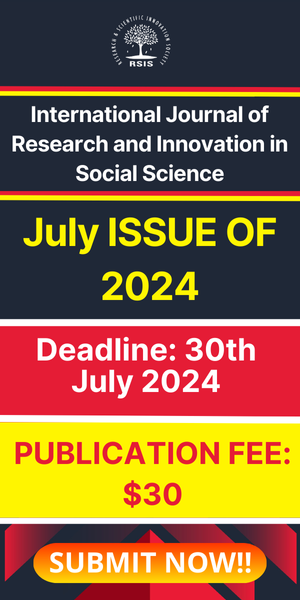The Impact of Environmental Management Practice on Ground Water Quality in Mubi Metropolis, Adamawa State, Nigeria.
- September 22, 2021
- Posted by: rsispostadmin
- Categories: Geography, IJRISS, Social Science
International Journal of Research and Innovation in Social Science (IJRISS) | Volume V, Issue VIII, August 2021 | ISSN 2454–6186
Garandi Ijudigal Danjuma
Department of Geography, Adamawa State University’ Mubi, Adamawa State, Nigeria.
Abstract: The research work, the impact of environmental management practice on groundwater quality in Mubi was investigated. The investigation was carried out base on water pollution sources, which include Septic Tank, Cesspool, Deep Discharge Injection of waste, refuse disposal, Fertilizers, pit latrines Waste/dead decayed matter, Insecticides /herbicides chemicals, and groundwater infiltration and percolation. A total of eight sampling points were selected from different sources from which water was obtained by the public, and analysis was carried out using Atomic Absorption Spectrophotometer (AAS) for indicators of faecal pollution, heavy metals and other contaminants. The study revealed that the content of pH, TDS, Total hardness, Chloride, Sodium and Potassium, Sulphate, Fluoride and Coliforms, were ranged 6.87-8.50, 1210-1520mg/L,127-295mg/L, 51-81mg/L, 20-54mg/L and 12-33mg/L,36-57mg/L,0.75-1.25mg/L and 130-180cfu/100ml, respectively. It shows that there is high contents of TDS, Total Hardness and Coliforms above the recommended maximum permissible limit prescribed for drinking water quality by WHO, (2013).
Keywords: Environmental management, Impact, contamination, Groundwater quality
I. INTRODUCTION
Now more than ever, firms are interested in developing environmental systems and practices. Because of growing environmental regulations, government pressures, international certification standards such as the International Organization of Standards, (ISO) 14000, changing customer demands, and managers recognizing pollution as waste (Kleiner 1991; Porter and Van Der Linde 1995), firms must now develop environmental policies for their manufacturing plants and supply chain partners while being consistent with new regulations (Rondinelli and Vastag 1996). Consequently, not only researchers, but also manufacturing managers are recognizing the importance of systems used to manage environmental practices. For managers deciding how to tackle environmental issues, however, transforming this recognition into the development of an Environmental Management System (EMS) can be difficult.
As groundwater is not visible it can be challenging to monitor the health and sustainability of your water source. Having a healthy and reliable supply of groundwater is paramount to high consumption users. (WHO, 2013).


